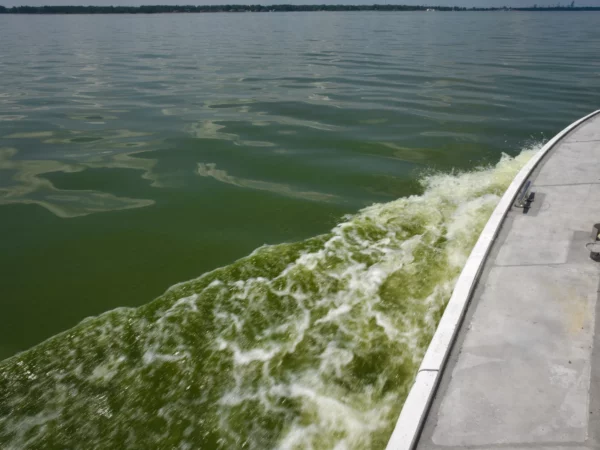
For Dr. Mona Hanna-Attisha, advocating for safe drinking water for Benton Harbor was an easy decision.
She called it a “duh” moment, a “choiceless choice.” Of course she would join a group of citizens and activists in requesting the U.S. EPA to use its emergency intervention authority in Benton Harbor, she said.
It was Hanna-Attisha who revealed that Flint children were exposed to lead in their drinking water. That was a watershed moment in the Flint water crisis. Her book, What the Eyes Don’t See, chronicles the discovery, the backlash she received and how the city of Flint was put at risk.
Great Lakes Now’s Gary Wilson spoke with Hanna-Attisha about the current Benton Harbor drinking water crisis which bears similarities to Flint’s. They covered Michigan’s slow-moving response to Benton Harbor’s lead levels, that both cities are emblematic of environmental injustice and she provided tips for parents who must cope with the risk of lead to their children.
The interview was conducted on the phone and was recorded, transcribed and edited for clarity and length.
Great Lakes Now: Is the water coming from Benton Harbor’s taps safe to drink? Especially for children?
Dr. Mona Hanna-Attisha: No, the water is not safe to drink and especially not for children. There is lead in the water, and there’s been lead in the water for too long. We know what lead does, and it is absolutely not safe for anyone to be drinking at this time.

Dr. Mona Hanna-Attisha (Photo courtesy of Mike Naddeo Photography)
GLN: You wrote in What the Eyes Don’t See that you feared no one would listen when you released your Flint lead level findings, a turning point in the crisis. Are government officials in Michigan and the U.S. EPA listening now concerning Benton Harbor’s lead levels?
MHA: I think they are listening now. It’s taken a while but action to protect the people of Benton Harbor is beginning to happen. From what I understand, the EPA has been quite responsive. The multiple departments of the state are also beginning to have a more holistic response, especially prioritizing bottled water at this point.
GLN: Do you see similarities between what happened in Flint and what’s taking place in Benton Harbor?
MHA: I think there are. The most striking similarity is the demographics of the population. Flint was this emblematic example of what environmental injustice is. Of how a predominantly poor and minority population disproportionately suffers the burden of environmental contamination. That’s what we see in Benton harbor as well. It’s a predominantly poor and minority city. As we take it a step further, it’s also a city that was under emergency management.
It’s also a city that lost democracy and has been under-resourced. It has really been a victim of long-standing austerity and racism over time.
There’s also a similarity in the response. In public health we fail to be driven by prevention, by finding a problem and fixing it. Or making sure problems don’t happen in the first place. We tend to be reactive and crisis driven. Flint never should have gone on as long as it did, and the situation in Benton Harbor should not be going on as long as it is.
GLN: You joined Benton Harbor residents and advocate groups in signing a formal petition requesting the U.S. EPA use its emergency authority to intervene in Benton Harbor. What prompted you to take that step?
MHA: Just like my work in Flint, being involved in this issue and signing that petition, I’d refer to the decision as a choiceless choice. It was a “duh” moment, of course I will help. Of course I will sign this petition. Whatever we can do to elevate this issue, draw increased attention to it by the federal and state governments to come up with a solution. It’s something I would do again and have been doing.
When I testified a few months ago before Congress regarding the national effort to remove all of our nation’s lead pipes as part of the Biden infrastructure bill, I said Flint wasn’t the worst crisis and it wasn’t the last. Since Flint, the list goes on and there have been multiple water crises not just in cities but in schools all over the nation. Benton Harbor is the most recent one. Since Flint, I’ve had the privilege of trying to help many other cities and communities with similar issues. Hopefully, Benton Harbor will be the last.
GLN: In her 2018 election campaign, Gov. Whitmer said a contributor to the Flint water crisis was when “communities of color are ignored when they speak out.” Is that the case currently in Benton Harbor, which is predominantly Black?
MHA: That’s one of the factors. It’s another example of environmental injustice with the demographics of the population contributing to the disaster. Yes, that’s part of it.
Gov. Whitmer’s administration has been trying to learn the lessons of Flint.
There are examples that took place right after she took office which attempted to address a lot of these issues. We have a position that we never had before and that most states don’t have, the environmental justice advocate. There’s a person full time who is supposed to have her pulse on these sorts of issues. In response to Flint, there’s now a clean water advocate to be a liaison to communities who feel their issues may not be heard.
Gov. Whitmer’s first executive order was a whistleblower protection order to encourage state employees to speak up when there’s something that could be harming the health and safety of Michiganders. That’s a definite response to Flint. I think the administration is trying to make sure there are no future Flints.
GLN: In the best of circumstances, full lead line replacement in the U.S. is a decade or two away. What’s your advice to parents of young children – be they from Benton Harbor, Buffalo or Chicago – to protect them from lead poisoning?
MHA: Oh, that’s a great question. What I’ve learned over these last few years is that our water was never intended to be lead free. The Lead and Copper Rule, which is part of the Safe Drinking Water Act, hasn’t caught up with science. Even the proposed recent revisions don’t fully respect the fact that there’s no safe level of lead.
I’m hopeful that we can strengthen this rule and remove the largest burden of lead in our drinking water delivery system which are these lead service lines. But that doesn’t eliminate the risk. There is also lead in the plumbing inside the house in the faucets and fixtures, and some of that lead wasn’t restricted until 2014. There’s a lot of lead in our plumbing. The long history of why speaks to the power of industries and their drive for profits.
If I’m sitting with a family, as I often do, and they’re worried about the potential of lead in water, whether there is a crisis or not, I recommend point-of-use lead-clearing filters. Also, there are basic water practices that we should be doing that the public is unaware of. For example, flushing. Whenever water hasn’t been in use for at least six hours or overnight, we should be flushing our cold water at the lowest level of our house until the water is super cold.
We should be removing and cleaning the aerators at the end of the faucet because they can trap particulates of lead. And use cold water for cooking and drinking.
Catch more news on Great Lakes Now:
City in Michigan urged to use bottled water due to lead risk
Michigan sending water, filters to Benton Harbor due to lead
Featured image: Dr. Mona Hanna-Attisha (Photo Credit: Michigan State University College of Human Medicine)




